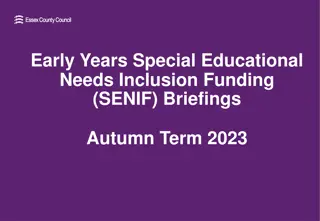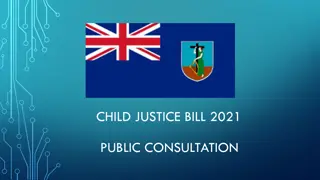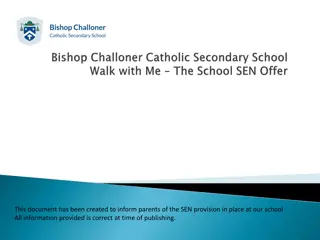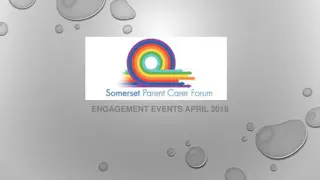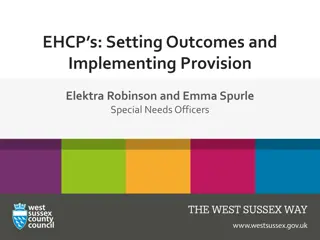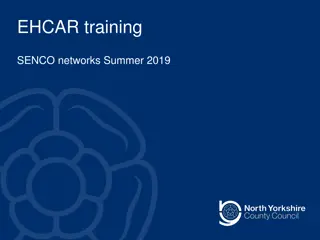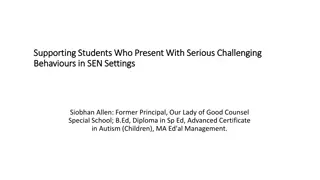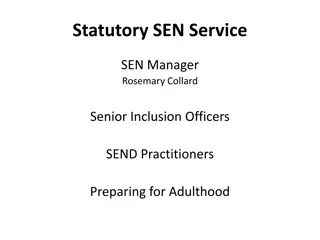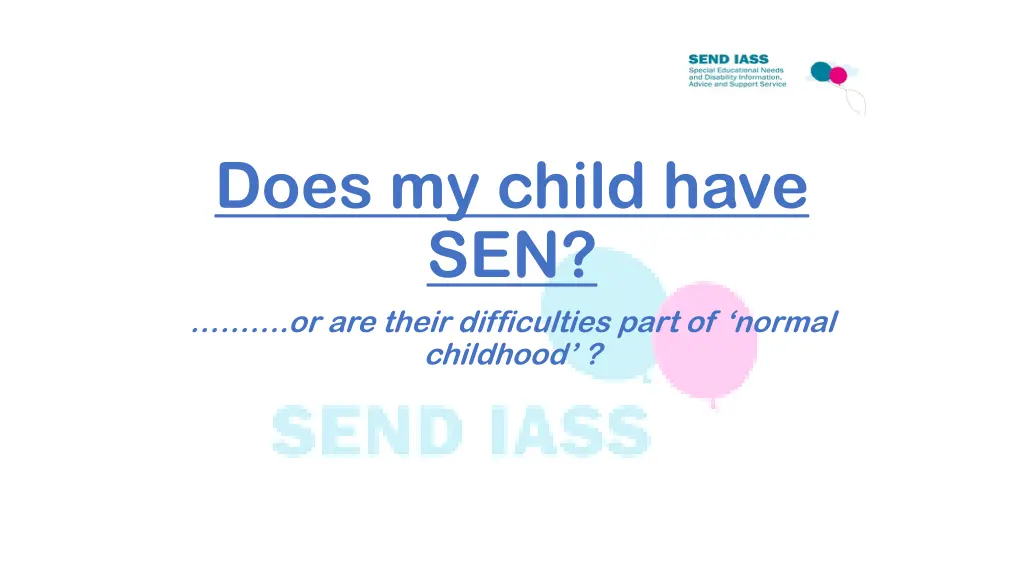
Understanding Special Educational Needs in Children
Discover the signs and types of Special Educational Needs (SEN) in children, including communication difficulties, cognitive challenges, and more. Learn how to identify if your child's struggles are a part of normal childhood or indicative of SEN.
Uploaded on | 0 Views
Download Presentation

Please find below an Image/Link to download the presentation.
The content on the website is provided AS IS for your information and personal use only. It may not be sold, licensed, or shared on other websites without obtaining consent from the author. If you encounter any issues during the download, it is possible that the publisher has removed the file from their server.
You are allowed to download the files provided on this website for personal or commercial use, subject to the condition that they are used lawfully. All files are the property of their respective owners.
The content on the website is provided AS IS for your information and personal use only. It may not be sold, licensed, or shared on other websites without obtaining consent from the author.
E N D
Presentation Transcript
Does my child have SEN? .or are their difficulties part of normal childhood ?
Definition of Special Educational Needs Those children who have learning difficulties or disabilities that make it harder for them to learn than most children of the same age. These can be: social emotional intellectual behavioural physical sensory or a mixture of some or all.
Tell tale signs of SENs Difficulties may occur with: all school work specific areas of school work such as reading, writing, numeracy, understanding or processing self expression or expressing and understanding what others are saying listening or paying attention establishing relationships, making friends or relating to adults behaving appropriately in or out of school personal organisation motor skills: may be impaired or slow Sensory or physical needs a combination of any of the above
Types of Special Educational Need What are the four main areas of SEN? 1. Communication and Interaction 2. Cognition and Learning 3. Behaviour, Emotional and Social Development 4. Sensory and/or Physical Every child is unique. An individual child s needs may not fall neatly into any one box and the Code of Practice recognises this. Many children have a mixture of special educational needs; others may only have one out of the main areas of need.
Communication and Interaction Q. What could my child find difficult at school if they can t communicate well? A. Children with communication difficulties may have trouble listening to the teacher, concentrating and remembering what they are taught. They may have problems developing friendships with other children. Sometimes they may have trouble knowing how to behave appropriately in different situations. There are two main types of communication difficulty: 1.Speech and language difficulties, or 2.Autistic spectrum/social communication difficulties
Cognition and Learning Q. What could my child find difficult at school if they have Cognitive difficulties? A. Children with cognitive difficulties usually find it hard to work at a fast pace and need to have work set at the individual level. They may have the following learning needs: 1. 2. Specific learning difficulties, such as a specific problem learning to read. General (or global ) learning difficulties which can be moderate learning difficulties (MLD), severe learning difficulties (SLD) or profound and multiple learning difficulties (PMLD).
Behaviour, Emotional and Social Development Q. What could my child find difficult at school if they have behavioural, emotional and social difficulties? A. Children with behavioural, emotional or social difficulties could struggle with any of the following: Sitting still, listening without interrupting, concentrating they may be easily distracted, taking turns/working in pairs or groups, making friends, working independently, working for a long period of time, developing self-esteem and confidence, following instructions, expectations, rules and routines, managing emotions such as anger and grief, controlling aggressive or violent behaviour
Sensory and/or Physical needs Q. What could my child find difficult at school if they have sensory and/or physical needs? A. Children with sensory and /or physical needs may experience a very wide range of difficulties in school which will vary according to their specific medical condition. Some children may have a sensory impairment such as hearing loss (also known as hearing impairment) or difficulties with eyesight (visual impairment). Some children may have physical needs caused by conditions such as cerebral palsy or muscular dystrophy and have difficulties keeping up because they have to record their work in a different way. Other children may have a medical condition such as epilepsy or juvenile arthritis which can also have a significant impact on their learning if it is not possible to manage it effectively.
First steps to take 1. Speak with the child s teacher. This may be their class teacher or head of year. - evidence any work - discuss any changes with behaviour, anxieties, health - discuss any actions that need to be taken - make notes of recommendations/plan - make another date to meet and follow up After this meeting it is important to keep track of how your child is progressing if you do not feel that any progress has been made you should contact teacher again or consider the next step.
What is SEN Support Every child with special educational needs should have SEN support. This means help that is additional to or different from the support generally given to other children of the same age. The purpose of SEN support is to help children achieve the outcomes or learning objectives set for them by the school. Schools should involve parents in this process.
SEN support can take many forms, including: a special learning programme for your child extra help from a teacher or a learning support assistant making or changing materials and equipment working with your child in a small group observing your child in class or at break and keeping records helping your child to take part in the class activities making sure your child has understood things by encouraging them to ask questions and to try something they find difficult helping other children work with your child, or play with them at break time supporting your child with physical or personal care, such as eating, getting around school safely, toileting or dressing.
A graduated approach When your child is identified has having SEN, the school should use a graduated approach Plan Assess Do Review
Plan If the school decides that your child needs SEN support it must must tell you.
Do Your child s class or subject teacher is usually responsible for the work that is done with your child, and should work closely with any teaching assistants or specialist staff involved. All those who work with your child should be made aware of: their needs, the outcomes sought, the support provided and any teaching strategies or approaches that are required.
Review The school should review your child s progress, and the difference that the help your child has been given has made, on the date agreed in the plan. The SEND Code of Practice SEND Code of Practice says that Schools should meet with parents at least three times a year. If your child has not made reasonable progress it will be important to agree with the school what should happen next.
Where can I get more information, advice or support? You can find out more about SEN Support by: looking at the SEN Information Report on the school website talking to your child s teacher or the Special Educational Needs Coordinator looking at the Local Offer Local Offer reading Chapter 6 of the SEND Code of Practice SEND Code of Practice Contact the SEND IASS office 01983 825548 / email Sendiass@iow.gov.uk
USEFUL WEBSITES SEN Code of Practice: www.gov.uk/government/publications/send-code-of-practice-0-25 The Local Offer: www.iwight.com SENDIASS: www.iowsendiass.co.uk



